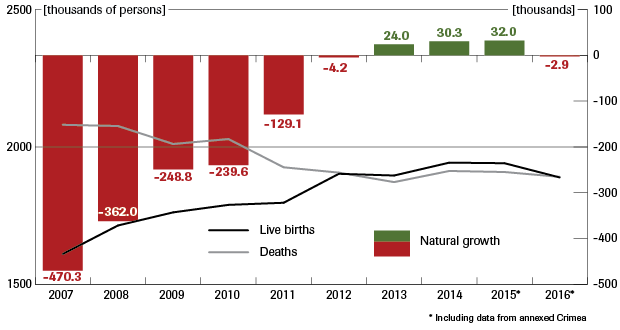Putin’s pro-family support programme
On 28 November, President Vladimir Putin announced the implementation of a programme for assistance to families. It provides for an allowance for the first child, for families whose income does not exceed 150% of subsistence level. The grant will be paid monthly to the child for 18 months. The size of the benefit will depend on the region, and on average will amount to about $180. The cost of this solution for the federal budget over three years has been estimated at 144.5 billion roubles (about US$2.5 billion). According to Deputy Prime Minister Olga Golodets, the benefits will be paid out to around 339,000 families. Moreover the so-called maternity capital programme, which was introduced in 2007, will be extended until 2021. This is a one-off benefit worth 450,000 roubles (US$7700), which is given for the second, third and subsequent children, in the form of a voucher for the purchase or renovation of an apartment, the education of a child or the pension of the mother. At the same time, changes to the regulations for paying out this benefit have been announced which will be more favourable for parents. The new steps also include the introduction of mortgages on preferential terms for families with two or more children, under which the state will give partial assistance with the repayments. All these changes will come into force as of 1 January 2018. In addition, the President has ordered the government to develop a detailed plan for the creation of a network of children’s health clinics by March 2018.
Commentary
- Putin’s announcement of this family support programme, a few months before the presidential election in which he will run again, is part of his pre-election campaign. The programme will not significantly burden public finances, and so will probably become an important element in Putin’s campaign, in which he will portray himself as the defender of traditional values, family and children. The beneficiaries of the programme will be the poorest social groups, who traditionally make up the president’s electorate: these are the recipients of social assistance from the state, accustomed to receiving such benefits, and who most recently have been harmed by the economic crisis. According to data from the beginning of 2017, approximately 15% of Russians (22 million) live below the poverty line, and more than half of this group are families with children.
- The family assistance programme is a continuation of the Kremlin’s policy aimed at improving the demographic situation. In Russia, the efforts made by the authorities so far have failed to resolve the demographic problems in a systematic manner. The improvement in the demographic indicators observed since 2012 has been presented by the Kremlin as a major success of Putin’s policy. In 2013, the number of births exceeded the number of deaths for the first time since the beginning of the 1990s. After the introduction of the maternity capital in 2007, total fertility rate increased in the next six years from 1.4 to 1.7 children per woman. This improvement in the indicators, however, was largely the result of the natural population cycle (as the generation of the previous baby boom entered into reproductive age). The demographic situation worsened again in 2016, when after three years of positive natural increase its value again fell below zero. The negative trends have been strengthening in 2017: in the period from January to October 1.418 million children were born, or about 170,000 less than in the same period in 2016 (a decrease of more than 10%). At the same time, however, some regions, for example the North Caucasian Federal District, are still distinguished by their very high natural increase , which generates additional problems from the point of view of Russia’s sustainable development.
- It is unlikely that the new package of support for families will significantly improve the demographic situation in Russia or reverse the negative trends. The worsening indicators are affected by the entrance into reproductive age of the generation born in the period of the birth rate decrease, as well as by the recent economic crisis – leading to a decline in the real incomes of the Russian people, and a deterioration in their access to health care.
Figure

Figures from Rosstat, http://www.gks.ru/wps/wcm/connect/rosstat_main/rosstat/ru/statistics/population/demography/#





